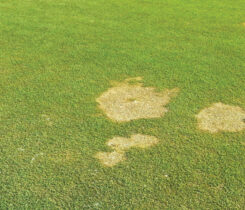Off the Record: How USGA grants advance the future of golf course management

Mike Kenna, Ph.D.
I am fortunate to serve as a volunteer committee member on the USGA Mike Davis Program for Advancing Golf Course Management. After directing the program for 30 years, it is rewarding to help plan future research, evaluate proposals and travel to see funded projects at universities.
The USGA allocates $1.8 million each year for 70 to 80 separate research projects through the USGA Davis Grants.
The annual investment in the program is part of the USGA’s continuous efforts to support the long-term health and sustainability of golf.
Overall, past research results save the golf industry an estimated $1.92 billion in operating costs annually, including:
⦁ $201 million for irrigation with evapotranspiration estimates of turfgrass water use
⦁ $530 million for irrigation scheduling with soil-moisture meters
⦁ $295 million for more efficient fertilizer and pesticide use
⦁ $243 million for implementing better putting green construction techniques
⦁ $174 million for converting to new turfgrass cultivars
⦁ $469 million for incorporating naturalized rough
Dollars at Work
The 2022 grant recipients include more than a dozen universities in the U.S. and represent both short- and long-term projects that focus on science-based management practices, turfgrass innovation and environmental stewardship. The grant recipients will receive an average of $88,000 in funding over the next three years. Individual grant awards range from $30,000 to $120,000.
Applicants for a USGA Davis Grant must demonstrate how their work will achieve one or more of the three main USGA strategic program objectives:
1) optimizing sustainable golf course management and playing conditions;
2) protecting and conserving water resources; or
3) identifying and developing novel plant materials.
Notable projects funded in 2022 include a national, multi-university evaluation of drought tolerance and water use of grasses commonly used for fairways; a Texas A&M project that aims to reduce fertilizer use with site-specific, digital estimates of nutrient requirements and turfgrass breeding programs at several universities improving the quality, stress tolerance and resource-use characteristics of turfgrasses.
Eye to the Future
Since the founding of the Green Section in 1920, the USGA has led the effort to enhance golf course sustainability through the development and support of research that produces a healthier environment and improved playing conditions.
The resulting sustainable management practices have contributed to a 20 percent decrease in water usage and an almost 40 percent decrease in nutrient usage by golf courses in the last decade.
Led by Cole Thompson, Ph.D., the research program is how the USGA brings to life its mission to champion and advance the game. In addition to this program, the USGA also invests in research that benefits other areas of course sustainability and golfer experience.












